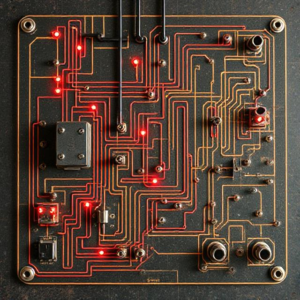Basic Electronic Components: Resistors, Capacitors, and Inductors
Electronic circuits rely on fundamental components imaged like resistors, capacitors, and inductors to manage current flow, store energy, and shape electrical signals. These components are the building blocks of devices ranging from simple gadgets to complex systems. This article explores their functions, working principles, types, applications, and key differences.

1. Introduction to Electronic Components
Resistors, capacitors, and inductors are essential for controlling how electricity behaves in a circuit. Each component has a unique role, enabling precise manipulation of current, voltage, and energy storage. Understanding these components is critical for designing and analyzing electronic systems.
2. Resistors
A resistor restricts the flow of electric current, acting as a control mechanism in circuits. Its resistance is measured in Ohms (Ω).
like resistors, capacitors, and inductors to manage current flow, store energy, and shape electrical signals. These components are the building blocks of devices ranging from simple gadgets to complex systems. This article explores their functions, working principles, types, applications, and key differences.
1. Introduction to Electronic Components
Resistors, capacitors, and inductors are essential for controlling how electricity behaves in a circuit. Each component has a unique role, enabling precise manipulation of current, voltage, and energy storage. Understanding these components is critical for designing and analyzing electronic systems.
2. Resistors
A resistor restricts the flow of electric current, acting as a control mechanism in circuits. Its resistance is measured in Ohms (Ω).
Key Functions
-
Current Limiting: Protects components by controlling the amount of current flowing through them.
-
Voltage Division: Creates specific voltage levels in circuits, such as in voltage divider configurations.
-
Heat Dissipation: Converts excess electrical energy into heat as it resists current flow.
How Do They Work?
Resistors obey Ohm’s Law, which relates current, voltage, and resistance:
I = V / R
Where:
-
I is the current (amperes)
-
V is the voltage (volts)
-
R is the resistance (ohms)
When voltage is applied across a resistor, it limits the current proportionally to its resistance value.
Types of Resistors
-
Fixed Resistors: Have a constant resistance value.
-
Variable Resistors (Potentiometers): Allow adjustable resistance, used in controls like volume knobs.
3. Capac| Capacitor | Stores energy in electric field | Farads (F) | Capacitance |
| Inductor | Stores energy in magnetic field | Henrys (H) | Inductance |
6. Applications
|
Component |
Example Applications |
|---|---|
|
Resistor |
Voltage dividers, LED circuits, current limiters |
|
Capacitor |
Power supply filters, timing circuits, energy storage |
|
Inductor |
Transformers, inductive sensors, RF circuits |
7. Summary
-
Resistors control current and voltage, ensuring safe operation of circuits.
-
Capacitors store and release electrical energy, aiding in filtering and signal processing.
-
Inductors manage energy in magnetic fields, excelling in filtering and AC circuit applications.
These components are indispensable in electronics, working together to enable the functionality of countless devices. Understanding their roles lays the groundwork for mastering circuit design and analysis.











